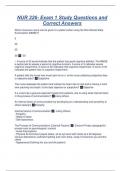Exam (elaborations)
NUR 226- Exam 1 Study Questions and Correct Answers
- Course
- Institution
Which maximum score can be given to a patient when using the Mini-Mental State Examination (MMSE)? 5 20 25 30 - 30 -- A score of 30 would indicate that the patient has good cognitive abilities. The MMSE is performed to assess a person's cognitive function. A score of 5 indicates severe cogniti...
[Show more]



